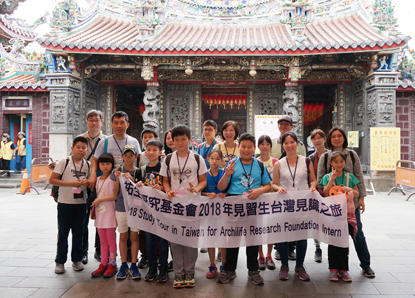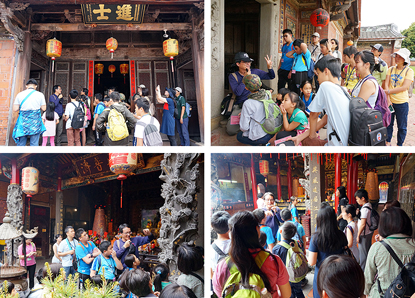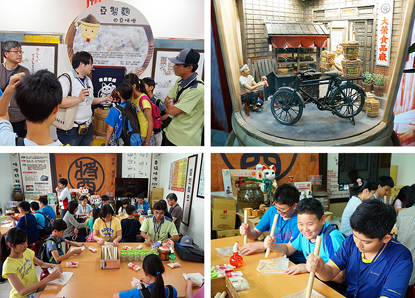Sketch of Archilife Study Tour, April 2018
|
2018年4月份見識之旅縮影  4月份見識之旅活動,於2018年4月21日由呂明澐小姐帶領19位祐生見習生及家長們,進行潭子摘星古宅走訪暨味噌釀造體驗之旅。活動開始之初,領隊呂明澐小姐提醒本次活動注意事項及觀察重點,先行建立見習生的背景知識。 4月份見識之旅活動,於2018年4月21日由呂明澐小姐帶領19位祐生見習生及家長們,進行潭子摘星古宅走訪暨味噌釀造體驗之旅。活動開始之初,領隊呂明澐小姐提醒本次活動注意事項及觀察重點,先行建立見習生的背景知識。For the study tour of April 21, 2018, Ms. Lu Ming-yun led 19 ARF interns and their parents on a tour to Zhaixing Villa in Tanzi and experience miso-making in Taichung. At the start of the day's activities, team leader Ms. Lu Ming-yun reminded everyone about things to note and what to observe, and provided the interns some general background knowledge.  本次上午行程由地方文史工作者陳仕賢先生擔任導覽老師。第一站參訪摘星山莊,由清代昭勇將軍林其中於1871年興建,耗時八年完工,是台灣少見的清代武官住宅。導覽老師首先介紹山莊的歷史背景與人文價值,接著講述山莊及其門樓坐落的方位,有朝氣蓬勃、聚財之意,並設置槍孔、垂直門閂以抵禦盜匪入侵。此外,門廳前方有一半月池,不僅能養鴨鵝防盜,亦兼具灌溉排水及風水作用。隨後導覽老師詳細解說宅邸內之雕塑彩繪與書法對聯象徵的意涵,即使在不易察覺的牆角,亦有精美磚雕相互呼應,足見摘星山莊無處不雕、無處不繪的華麗建築風格。離開摘星山莊後,前往豐原媽祖廟參觀,導覽老師以廟宇藝術為主軸,講述該廟因歷經多次重建與修繕,許多繪畫雕刻作品完成於不同年代,皆是名匠師嘔心瀝血的佳作,可見其對於傳統文化的珍貴性。 本次上午行程由地方文史工作者陳仕賢先生擔任導覽老師。第一站參訪摘星山莊,由清代昭勇將軍林其中於1871年興建,耗時八年完工,是台灣少見的清代武官住宅。導覽老師首先介紹山莊的歷史背景與人文價值,接著講述山莊及其門樓坐落的方位,有朝氣蓬勃、聚財之意,並設置槍孔、垂直門閂以抵禦盜匪入侵。此外,門廳前方有一半月池,不僅能養鴨鵝防盜,亦兼具灌溉排水及風水作用。隨後導覽老師詳細解說宅邸內之雕塑彩繪與書法對聯象徵的意涵,即使在不易察覺的牆角,亦有精美磚雕相互呼應,足見摘星山莊無處不雕、無處不繪的華麗建築風格。離開摘星山莊後,前往豐原媽祖廟參觀,導覽老師以廟宇藝術為主軸,講述該廟因歷經多次重建與修繕,許多繪畫雕刻作品完成於不同年代,皆是名匠師嘔心瀝血的佳作,可見其對於傳統文化的珍貴性。Local culture-history research worker Mr. Chen Shih-hsien was the tour guide for the morning's itinerary. The first destination visited was Zhaixing Villa. The villa, which was built in 1871 by General Lin Chi-chung during the Qing Dynasty, took eight years to complete and is one of the rare few Qing Dynasty residences in Taiwan that belong to a military officer. Mr. Chen began by introducing the historical background and cultural value of the villa. He then went on to explain that the position of the villa and its gatehouse symbolizes vitality and wealth, and vertical door latches and loopholes were used as defense against robbers and invaders. Moreover, the crescent-shape pond in front of the entrance hall was not only used for raising ducks and geese but also for burglary prevention, and for irrigation, drainage and fengshui purpose. Mr. Chen also explained the symbolism and meanings of the exquisite sculptures and paintings, and calligraphy couplets in the villa. Even exquisite brick carvings can be found in inconspicuous corners of the walls, which is clearly evident of the elaborate and ornate architectural style seen everywhere in the villa. After leaving the Zhaixing Villa, everyone went to visit the Fengyuan Tzu Chi Temple. Focusing on temple art, Mr. Chen explained that the paintings and sculptures are from different eras because the temple has gone through many reconstructions and renovations. However, famous craftsmen had poured their heart and soul into creating all these works, further affirming their value in traditional culture.  中午飯後,乘車至台灣味噌釀造文化館,導覽人員藉由投影片簡介味噌文化淵源、釀造等相關知識,並透過一旁模型重現古早時期如何進行味噌買賣,期間以有獎徵答的方式互動,見習生皆踴躍舉手發言。緊接著,導覽人員帶領眾人實際認識製做味噌的原料,鼓勵見習生以觀看、嗅聞及觸摸來觀察原料之間的差異,找出製做味噌的最佳組合,隨後說明依發酵時間及原料的不同,味噌的色澤氣味也會出現深淺濃厚的變化,形成多樣種類。最後進行味噌DIY活動,於導覽人員解說下,眾人一步步將煮熟黃豆以桿麵棍壓碎,加入米麴後揉捏成團狀,最後裝罐並於上層塗薄鹽即完成,藉此不僅可讓見習生了解味噌實際製做過程,亦能體會早期手工製做的辛勞。至此,本日活動已近尾聲,大家一起合照留念後各自返家,並期待於下次見識之旅再相見。 中午飯後,乘車至台灣味噌釀造文化館,導覽人員藉由投影片簡介味噌文化淵源、釀造等相關知識,並透過一旁模型重現古早時期如何進行味噌買賣,期間以有獎徵答的方式互動,見習生皆踴躍舉手發言。緊接著,導覽人員帶領眾人實際認識製做味噌的原料,鼓勵見習生以觀看、嗅聞及觸摸來觀察原料之間的差異,找出製做味噌的最佳組合,隨後說明依發酵時間及原料的不同,味噌的色澤氣味也會出現深淺濃厚的變化,形成多樣種類。最後進行味噌DIY活動,於導覽人員解說下,眾人一步步將煮熟黃豆以桿麵棍壓碎,加入米麴後揉捏成團狀,最後裝罐並於上層塗薄鹽即完成,藉此不僅可讓見習生了解味噌實際製做過程,亦能體會早期手工製做的辛勞。至此,本日活動已近尾聲,大家一起合照留念後各自返家,並期待於下次見識之旅再相見。After lunch, everyone took the bus to Miso Cultural Factory. The guide gave a slideshow presentation to introduce the origin of miso culture and knowledge about miso brewing, and through models exhibited at the factory, the interns learned about miso trading in the past. The interns also responded spontaneously during the quiz contest to win prizes. Next, the tour guide showed everyone the ingredients that go into making miso, encouraging the interns to look, smell and touch them to observe their differences and to find the best combination for making miso. They also explained that differences in brewing time and ingredients will change the color and smell of the miso, creating various types of miso. During the DIY activity, everyone learned to mash cooked soybeans with a rolling pin, add rice yeast and knead the mixture into a ball shape, and finally placing it in a container and topping it with a thin layer of salt. The interns not only had hands-on experience in making miso but also learned the difficulty of manually making miso in the early days. At this point, the day's itinerary came to an end. Everyone returned to home after taking a group photo and looked forward to the next study tour. |

